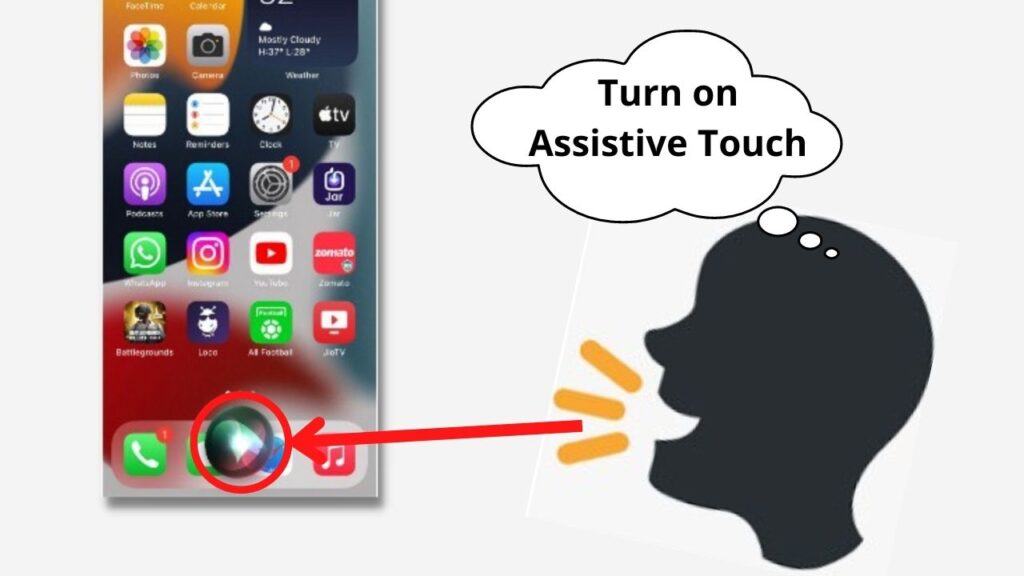Users who often use iPhone are accustomed to using the small white dot to assist the Home button function, but the system does not enable it by default. The new iPhone 13 has cancelled the physical Home button. The following article will teach you how to enable assistive touch on iphone.
◆ How to enable assistive touch on iphone 13?
Let’s see the full process of how to enable assistive touch on iphone 13 :
1. Go to “Settings” – “Accessibility” -“Accessibility Shortcut”- “Assistive Touch”, then enable “Assistive Touch“;

2. Open Siri and use the voice command “Turn on Assistive Touch”;

- 3. Go to Settings – General – Accessibility – Accessibility Shortcuts, then turn on Assistive Touch.
- After opening “Assistive Touch”, you can see the “Assistive Touch” menu;
- You can drag the “Assistive Touch” button to any edge of the screen, tap the menu to open it, and tap the menu under the open turntable to close the Assistive Touch menu;
- Open the “Accessibility” menu, tap “Device”, tap and hold “Lock Screen” until the shutdown slider appears, you can turn off the device;
- Open the “Accessibility” menu and tap “Home Screen” to access the device’s home screen;
- Open the Accessibility menu and tap Notification Center to access your device’s notifications;
- Open the “Accessibility” menu, tap “Control Center”, you can turn on or disconnect the Bluetooth connection, use “AirPlay” or “AirDrop” and other operations.
Using 3D Touch with Assistive Touch:
iPhone 6s and later devices can use the “Assistive Touch” function to use 3D Touch, which can quickly complete some commonly used operations for sending messages, emails, and photos.
- Open the Assistive Touch menu and tap Customize to find and tap 3D Touch;
- With 3D Touch, tap the screen to preview the information, tap again to view the full content;
- Go to “Settings” – “General” – “Accessibility” – “Assistive Touch”, and go to the “Customize Top Menu” tab to modify the 3D Touch operation.
◆ How to configure assistive touch on iPhone 13?
If the “Home” button on your iPhone no longer works or begins to show some signs of weakness, you will naturally have difficulty using your phone properly. Fortunately, Apple anticipated this kind of problem by creating the “Assistive Touch” feature, which may also appeal to those who deplore the arrival of new iPhones without a central button.
This option allows you to set up a “Home” button anywhere on the screen, with even additional features that you can customize, according to your uses and preferences. Find out how to use this little-known feature among many users who are used to the apple brand.
- To start, you must go to your iPhone settings, and go to the “General” section.
- Next, Go to Accessibility settings.
- Scroll down the page, as the “Assistive Touch” feature usually doesn’t appear at first. When you find it, tap it to activate and customize it.
You arrive in the parameters of the Assistive Touch. Start by activating the button at the very top so that the “Home” button is added on your iPhone screen. You can then move it manually to place it where you prefer it on the screen surface.
In the “Customize the menu” section, you can change the icons that appear by long pressing Assistive Touch, which replaces the Home button, but also allows quick access to certain features.
Choose the icons you want to add based on your practices and preferences.
You can even create gestures that can be associated with different features.
You will understand, even if your Home button does not work properly, nothing is lost. If your iPhone is still under warranty, we naturally encourage you to contact the after-sales service for a repair.
Otherwise, you can use the Assistive Touch, or bear the repair costs. Note that even when the Home button works, nothing prevents you from adding this rather interesting feature to your iPhone, if you have a recent model without a Home button and you are missing it, for example.
What is Assistive Touch?
This is the virtual home button. It activates automatically when the home button fails . It thus allows you to navigate and access your applications as if there were still the physical home button. You also have the option of activating it manually if you want to add shortcuts, even if the home button works or if it has disappeared from new generations.
The only issue you will have with the Assistive Touch will be the ability to restore your iPhone or enter DFU mode . Ditto with the Touch ID which, by logic, will not work (the sensor being on the home button). If the physical home button is no longer functional, these manipulations cannot be performed. Hence the interest of installing a universal home button if necessary !
I’m sourav, from Kolkata. A tech lover and love to answer any tech-related queries. I just try answering all questions like my problem.

